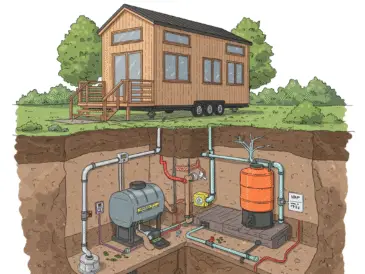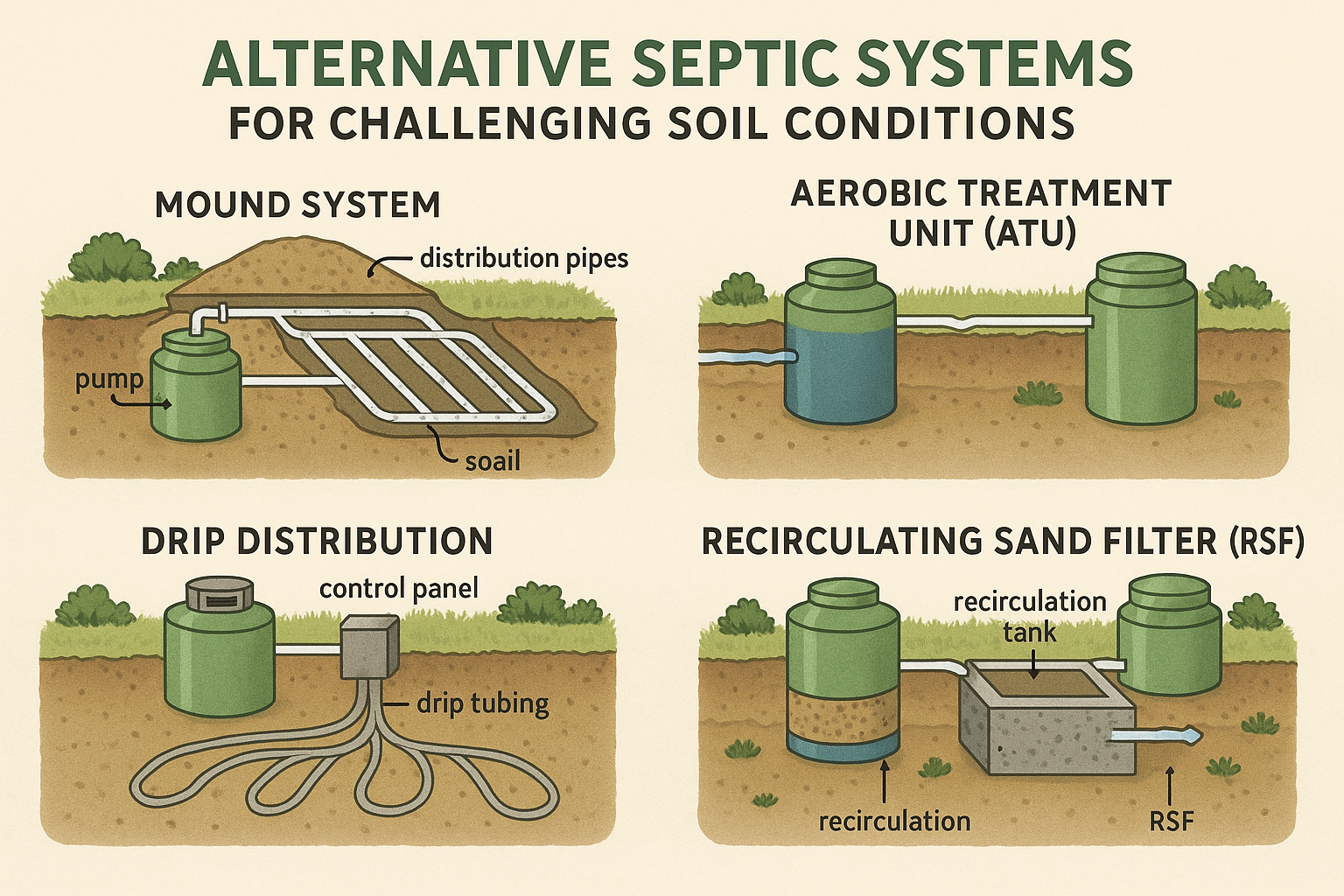Installing a septic system isn’t exactly the kind of project you wake up excited about, but it’s one of those necessary evils that can make or break your property dreams. Whether you’re building a new home in a rural area or replacing a failing system, navigating the maze of permits and inspections can feel like trying to solve a Rubik’s cube blindfolded. The good news? With the right knowledge and preparation, you can turn this potentially frustrating process into a smooth operation that protects both your investment and the environment.
Regulatory compliance isn’t just bureaucratic red tape—it’s your safety net against costly mistakes, environmental damage, and legal headaches down the road. A properly permitted and inspected septic system not only functions better but also adds value to your property and keeps you on the right side of local health authorities.
This comprehensive guide will walk you through every step of the septic installation permit and inspection process, from understanding why these requirements exist to celebrating that final approval. By the time you finish reading, you’ll have the confidence to tackle this project like a pro and avoid the common pitfalls that trip up countless homeowners every year.
Understanding Septic System Installation
A septic system is essentially your home’s personal wastewater treatment plant. It’s an underground system that treats and disposes of household wastewater in areas where centralized sewer systems aren’t available or practical. The system typically consists of a septic tank, distribution box, and drain field (also called a leach field), all working together to break down waste and filter water back into the ground safely.
Homeowners typically need a septic system when building in rural or suburban areas without access to municipal sewage treatment, or when an existing system fails beyond repair. Sometimes, expanding your home or adding bathrooms triggers the need for a larger system or complete replacement. The key is recognizing these needs early and planning accordingly.
The installation process involves several phases: site evaluation and soil testing, system design, permit application, excavation, installation of components, backfilling, and final inspection. Each phase has specific requirements and potential inspection points, making proper planning essential for success.
Why Septic Installation Permits Are Required
Local and state authorities require septic permits because your system directly impacts public health and environmental safety. These aren’t arbitrary regulations designed to complicate your life—they’re protective measures based on decades of experience with failed installations and their consequences.
From an environmental standpoint, improperly installed septic systems can contaminate groundwater, pollute nearby wells, and create unsanitary conditions that affect entire communities. Health departments have seen too many cases of waterborne illnesses traced back to faulty septic installations to take chances with DIY approaches or corner-cutting contractors.
“I’ve investigated countless groundwater contamination cases over my 25-year career, and the vast majority trace back to unpermitted or improperly installed septic systems. The permit process isn’t a hurdle—it’s your insurance policy against environmental disaster.”
– Dr. Sarah Mitchell, Environmental Health Specialist
The consequences of skipping proper permits can be severe and expensive. You might face stop-work orders, fines, required system removal and reinstallation, and legal liability for any environmental damage. Some jurisdictions can even place liens on your property until violations are corrected. The upfront cost of permits and inspections is minimal compared to these potential consequences.
The Septic Permit Application Process
Your first stop is typically the local health department or building authority, though this varies by location. Some areas have dedicated septic permit offices, while others handle these applications through general building permit departments. Call ahead to confirm the correct office and their specific requirements.
The application package usually includes site plans, soil percolation test results, system design drawings, and proof of property ownership. You’ll also need to provide information about your home’s square footage, number of bedrooms and bathrooms, and expected daily wastewater volume. Many jurisdictions now require engineered designs for systems over certain sizes or in challenging soil conditions.
Professional designers and engineers play a crucial role in this process. They conduct soil tests, design systems that meet local codes, and prepare the technical drawings required for permit applications. While hiring professionals adds to upfront costs, their expertise often prevents costly delays and design problems later.
Permit fees typically range from $200 to $800, depending on your location and system complexity. Processing times vary widely—some jurisdictions approve straightforward applications within a week, while others take 30 days or more. Complex sites or busy permit offices can extend timelines even further, so apply early in your project schedule.
Preparing for Septic System Inspections
Septic installations typically involve multiple inspection points throughout the process. The first inspection often occurs after excavation but before any components are installed, allowing inspectors to verify proper depth, soil conditions, and setback distances. Additional inspections happen during installation and after completion but before backfilling.
Inspectors focus on different elements at each phase. During excavation inspection, they check hole dimensions, soil consistency, and compliance with setback requirements from wells, property lines, and buildings. Installation inspections verify proper tank placement, connection integrity, and material compliance. Final inspections ensure everything is properly connected and the system is ready for operation.
Working closely with your contractor during this process is essential. Experienced installers know when to schedule inspections and what inspectors expect to see. They should coordinate directly with the inspector’s office and notify you of scheduled inspection times. Never allow contractors to proceed to the next phase without required inspection approvals.
Common Inspection Failures and How to Avoid Them
Improper tank placement or sizing ranks among the most common inspection failures. Tanks installed too close to buildings, wells, or property lines violate setback requirements and must be relocated. Undersized tanks for the home’s capacity create immediate compliance issues. Always verify measurements and consult local setback charts before installation begins.
Using non-approved materials is another frequent problem. Some contractors try to save money with generic components that don’t meet local specifications. Always insist on materials that carry proper certifications and approvals for your jurisdiction. When in doubt, ask inspectors for approved product lists before purchasing.
“The biggest mistake I see is homeowners trusting contractors who say ‘don’t worry about permits.’ A legitimate contractor should be eager to pull permits because it protects everyone involved. Red flags should go up immediately if someone suggests cutting corners on permitting.”
– Mike Rodriguez, Licensed Septic Inspector
Inadequate soil testing or drainage issues often surface during inspection. Some contractors skip proper percolation testing or ignore marginal soil conditions, leading to systems that can’t function properly. Insist on thorough soil analysis and consider engineered solutions for challenging sites rather than hoping basic systems will work.
To pass inspections consistently, maintain open communication with inspectors, follow approved plans exactly, and address any concerns immediately. Keep all documentation organized and easily accessible during inspections. Most inspectors appreciate well-prepared contractors and responsive homeowners who take the process seriously.
Role of Licensed Contractors and Inspectors
Hiring certified professionals isn’t just recommended—it’s essential for success. Licensed septic contractors understand local codes, have relationships with permit offices, and carry insurance that protects you from installation problems. They also stay current on changing regulations and new installation techniques.
Experienced contractors handle much of the permit and inspection coordination, saving you time and reducing stress. They know which inspectors to work with, when to schedule inspections, and how to address common concerns before they become problems. This expertise often pays for itself through faster approvals and fewer delays.
When interviewing potential installers, ask about their licensing status, insurance coverage, and recent similar projects. Request references from recent customers and follow up on them. Ask how they handle permit applications and inspection coordination. Be wary of contractors who seem unfamiliar with local requirements or suggest shortcuts around proper procedures.
Maintenance Requirements Post-Installation
The final inspection marks the beginning, not the end, of your responsibilities. Inspectors verify that everything is properly connected, the system operates correctly, and all components meet specifications. This approval allows you to begin using the system and triggers any warranty periods.
Maintaining compliance involves regular pumping, periodic inspections, and prompt attention to any problems. Some jurisdictions require periodic compliance checks or maintenance reports. Stay current on these requirements to avoid violations that could affect your ability to sell the property later.
“Smart homeowners keep a comprehensive file with all permits, inspection reports, pumping records, and maintenance documentation. When it comes time to sell, this paperwork can be worth thousands in buyer confidence and smooth transactions.”
– Jennifer Hayes, Real Estate Attorney
Keep detailed records of all permits, inspection reports, and maintenance activities. These documents prove compliance and can be valuable during property sales. Many buyers specifically request septic system documentation, and complete records often expedite transactions and reduce buyer concerns.
Your Path to Septic Success
Navigating septic installation permits and inspections doesn’t have to be a nightmare. With proper planning, qualified professionals, and attention to regulatory requirements, you can complete your project efficiently and confidently. The key is treating permits and inspections as valuable safeguards rather than obstacles to overcome.
Following proper procedures protects your investment, ensures system longevity, and demonstrates responsible stewardship of environmental resources. The extra time and money spent on compliance pays dividends through better system performance, fewer problems, and easier property transactions down the road.
At SepticServiceCenter.com, we understand that septic projects can feel overwhelming. Our network of qualified professionals can guide you through every step, from initial planning to final approval. Whether you need design services, contractor referrals, or ongoing maintenance support, we’re here to make your septic installation a success story rather than a cautionary tale.




